Posey Bed 8070 User Manual
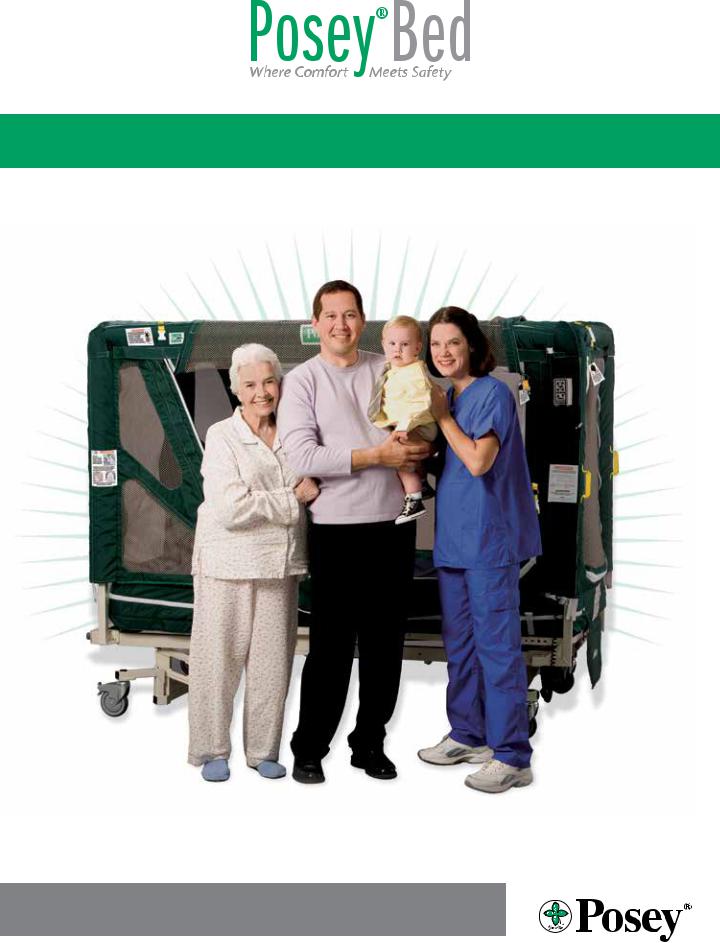
8070
Professional User Manual
Only for Joerns Bed model number 2003DC #B684DC modified for the Posey Bed
U.S. Pat. No. 7,735,167 |
Rx ONLY |
|
Posey Company • 5635 Peck Road, Arcadia, CA 91006-0020 USA
Phone: 1.800.447.6739 or 1.626.443.3143 • Fax: 1.800.767.3933 or 1.626.443.5014 • www.posey.com
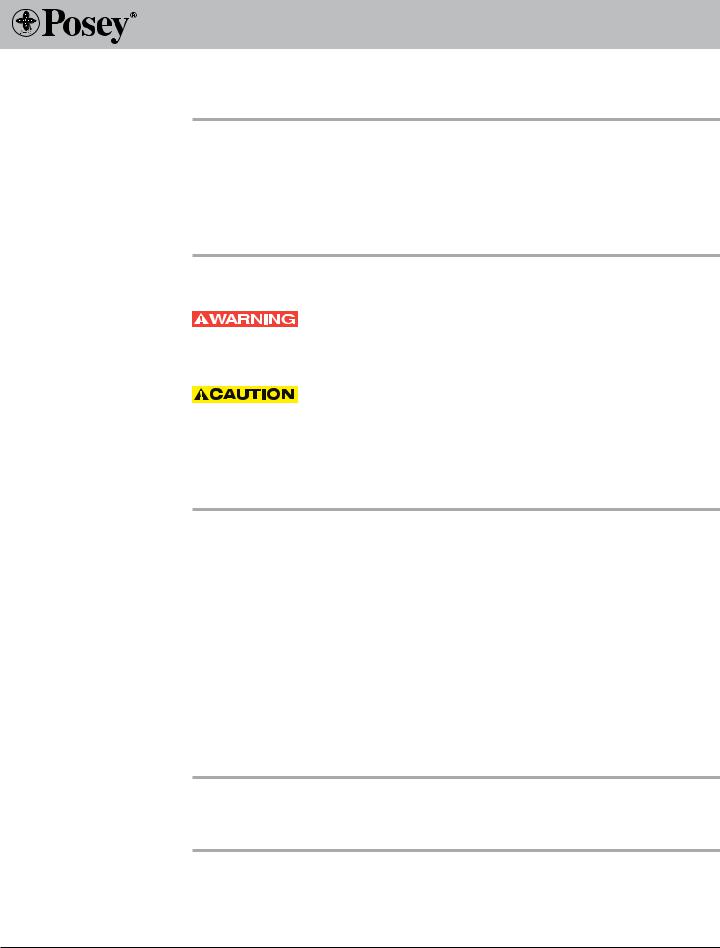
How to Use this Manual
Introduction
Symbols
Definitions
Need help?
This User’s Manual is intended for professionals providing care to patients in the Posey Bed who have successfully completed the Posey Bed In-Service Training Program.
In addition to this manual, you should also review:
•The Assembly Instructions
•The In-Service Training Manual
The symbols below are used throughout this manual and should be carefully read.
A Warning alerts you to a safety hazard or unsafe practice, which, if not avoided, could result in serious injury or death.
A Caution alerts you to a hazard, which, if not avoided, may result in minor or moderate injury to you or the patient, or damage to the Posey Bed.
Note
A Note provides helpful information to make bed use easier and more efficient.
The following words have special meaning when used in this Manual:
Biohazardous – matter that is contaminated with human blood; tissues; certain body fluids; recombinant DNA; or pathogens. Check with the patient’s physician if you have any questions about this hazard.
Care Plan – the patient’s Individualized Care Plan (ICP) as written by the IDHT (see below).
Interdisciplinary Healthcare Team (IDHT) – who writes the Care Plan and supervises patient care. The team may include, among others, Physicians, Nursing, Occupational Therapy, Physical Therapy and Social Services.
Entrapment – an event in which a patient is caught, trapped, or entangled in a confined space. This can result in serious injury or death from suffocation, compressions, or lack of proper blood flow.
If you need help or have any questions, please call Posey Customer Support at 1.800.447.6739 between 6:00 am PST, and 5:00 pm PST. You can also contact your authorized bed dealer.
2 |
Posey Bed 8070 |

Table of Contents |
|
Topic |
see Page |
Welcome to the Posey Bed 8070 .......................................................................................................................... |
4 |
About the Posey Bed 8070 ........................................................................................................................................ |
5 |
Contraindications .......................................................................................................................................................... |
6 |
A Special Note ................................................................................................................................................................. |
7 |
Patient Reassessment ................................................................................................................................................. |
8 |
Description of the Posey Bed 8070 .................................................................................................................... |
9 |
Parts of the Posey Bed 8070 System ................................................................................................................ |
10 |
Warnings and Precautions .................................................................................................................................. |
11-13 |
Basic Bed Operation ............................................................................................................................................ |
14-20 |
Install or Replace Mattress............................................................................................................................. |
14 |
Adjust the Bed ..................................................................................................................................................... |
15 |
Lock and Unlock the Casters ........................................................................................................................ |
16 |
Engage Transfer Brakes...................................................................................................................................... |
16 |
Zip and Unzip the Access Panels .......................................................................................................... |
17-18 |
Use Perimeter Guards ...................................................................................................................................... |
19 |
Use Transport Handles...................................................................................................................................... |
19 |
Use the Tube Ports ........................................................................................................................................... |
20 |
Before First Time Use .......................................................................................................................................... |
21-22 |
Check for Proper Bed Assembly ................................................................................................................. |
21 |
Guidelines for Proper Bed Location ........................................................................................................ |
22 |
Guidelines for Staff Training......................................................................................................................... |
22 |
New Patient Selection and Monitoring ......................................................................................................... |
23 |
Emergency Patient Access and Exit ................................................................................................................... |
24 |
Regular Daily Patient Care............................................................................................................................... |
25-29 |
Transfer Patient Into the Bed ....................................................................................................................... |
26 |
Access and Care for the Patient in the Bed .......................................................................................... |
27 |
Transfer Patient Out of the Bed ................................................................................................................. |
28 |
Quick-Check 10................................................................................................................................................... |
29 |
Quick Clean the Posey Bed .................................................................................................................................... |
30 |
Machine Washing the Posey Bed......................................................................................................................... |
30 |
Posey Accessories ......................................................................................................................................................... |
31 |
Troubleshooting and Frequently Asked Questions ................................................................................ |
32 |
Posey Limited Warranty .......................................................................................................................................... |
33 |
Posey Technical Service ........................................................................................................................................... |
33 |
Posey Bed 8070 |
3 |
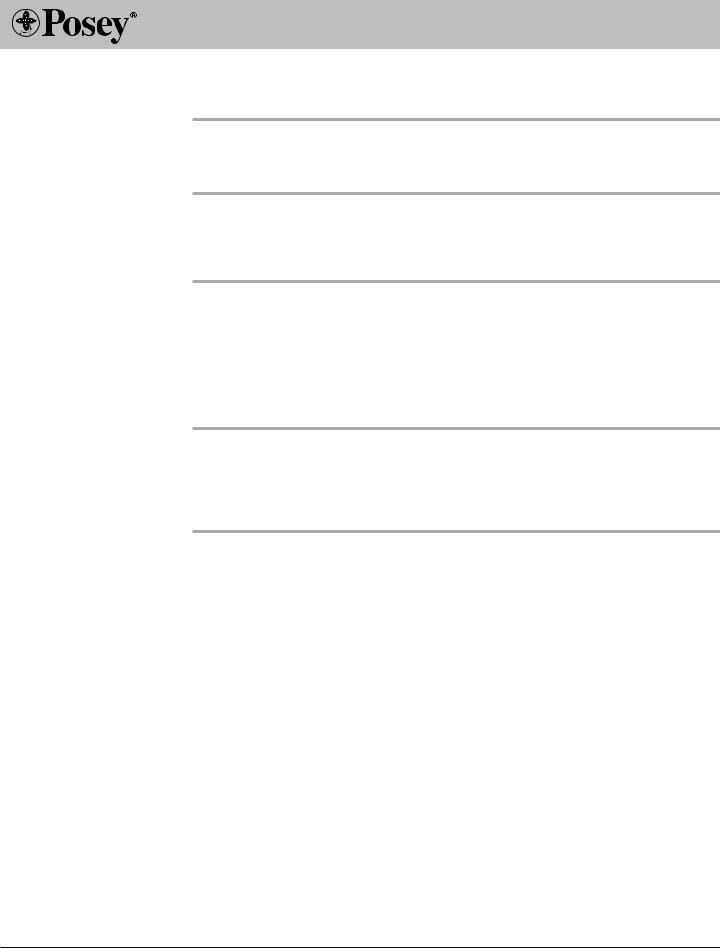
Welcome to the Posey Bed 8070
Introduction
Prescription Only
and Required
Training
Benefits
The Posey Bed 8070 is a hospital bed, canopy, and mattress system designed to help provide a safe, controlled environment for patients at extreme risk of injury from a fall or unassisted bed exit.
Because the bed is a restraint, its use must be prescribed by a licensed physician. Anyone interacting with the bed must complete the Posey Bed 8070 In-Service Training Program which includes proficiency in the use of this manual.
The Posey Bed was designed to help provide these benefits:
•A controlled patient environment,
•Reduce the risk of unassisted bed exit,
•Reduce the risk of patient falls,
•Avoid the risk of a patient being trapped under a mattress, and
•Eliminate the need for side rails when the patient is unattended. This avoids the risk of the patient being trapped in the side rails, or between the mattress and side rails.
Risks
Improper use of the Posey Bed may lead to serious injury or death. Patient monitoring should be established by hospital protocol and the patient’s care plan. As with any less restrictive restraint system, it is important to be familiar with the indications for use, the contraindications for use and in particular, risks associated with entrapment, suffocation, choking, and falls.
4 |
Posey Bed 8070 |

About the Posey Bed 8070
Indications for Use
The Posey Bed is a hospital bed, canopy, and mattress system designed to help provide a safe, controlled environment for patients at extreme risk of injury from a fall or unassisted bed exit. The Posey Bed is a less restrictive alternative to physical restraints such as belts, vests, or jackets for patients at least 46 inches tall, weighing between 46 and 300 pounds. The Posey Bed is a restraint, and must be prescribed by a licensed physician (Rx ONLY).
Bed Use
The bed must be used in accordance with:
•All state regulations
•Federal Center for Medicare & Medicaid Services (CMS) Regulations
•The patient’s care plan
•The policies of your facility
Patients Who May
Benefit
Patients who may benefit from the use of the Posey Bed include patients who are at extreme risk for a fall and/or unassisted bed exit including those with:
•Severe osteoporosis,
•Severe risk of fractures due to clinical conditions,
•Insufficient muscle, fat, and subcutaneous tissue to absorb the impact of a fall,
•Concurrent use of anticoagulants,
•A history of severe trauma in a prior fall,
•Conditions that cause uncontrollable movement such as Huntington’s Disease.
Clinical
Conditions
Certain patients at-risk for a serious injury from a fall may also benefit from the use of the Posey Bed. This includes patients with behavioral, physical, mental or other symptoms identified by the IDHT such as:
•Musculoskeletal problems that cause an unsteady gait or impaired strength or biomechanics,
•Altered awareness due to medication or neural illnesses or conditions that impair alertness and balance, and/or dementing illnesses,1
•Visual or peripheral neuropathies that impair positional sense.
Falls
Most falls occur in Neurology and Medical units, with the highest rate in Oncology units. Fall rates may be higher in units with higher patient to nurse ratios.2
1Dementia patients are at increased risk of falls. This may be due to impaired judgment, altered gait, and/or sensory deficits. Ellelt, Anne “Keeping Dementia Residents Safe” Assisted Living Consult, Sept/Oct 2007, page 20.
2 Hitcho, Eileen B. et al., “Characteristics and Circumstances of Falls in a Hospital Setting” JGIM, Volume 19, July 2004.
Posey Bed 8070 |
5 |
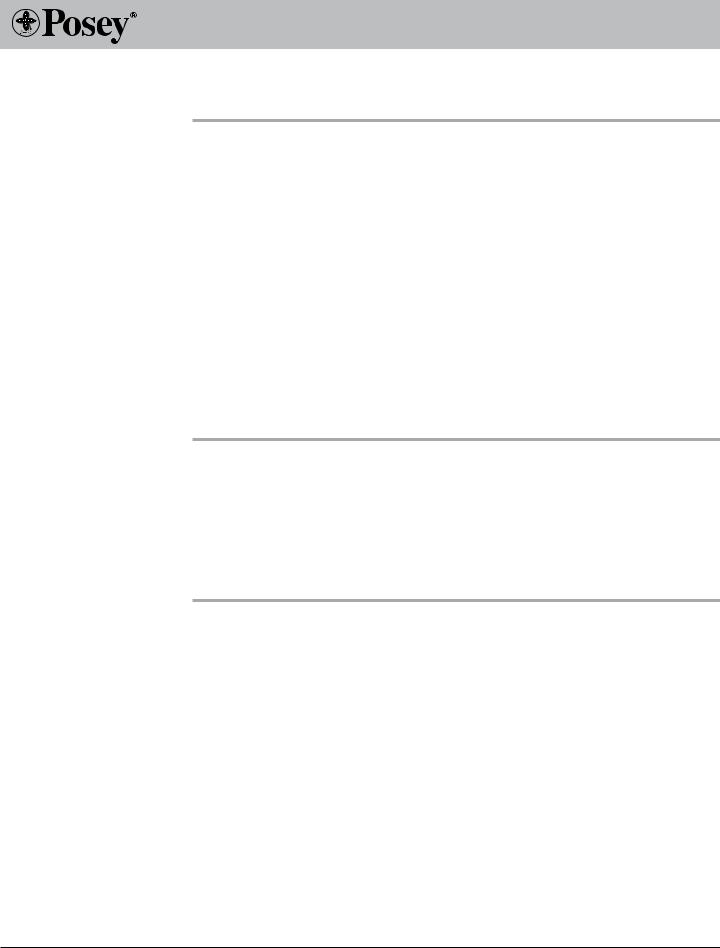
Contraindications
When Not to Use the Device
Given the nature of some patients’ diagnoses, activity level, or uncontrolled movements, the Posey Bed is not suitable for every patient.
The Posey Bed is not intended for use with:
•Patients who weigh less than 46 pounds, or are shorter than 46 inches.
–These patients are at risk of serious injury or death, and the Posey Bed 8070 has not been tested for use by such patients.
•Patients who weigh 300 pounds or more.
–This is the working load capacity of the bed.
•Patients diagnosed with any condition that may cause violent or self-destructive behaviors.
–These could result in self-injury and/or damage to the Posey Bed.
–Violent flailing of the body from side to side could cause the Posey Bed to tip over or move to a position where the patient is injured by contact with an object in the room.
•Patients with an excessive Pica eating disorder.
–This refers to a person who may attempt to eat the canopy or padding of the Posey Bed.
–Patients who suffer from this disorder include adults, and it is the most common eating disorder among children who are developmentally disabled.
•Patients who are, or who become, claustrophobic while in the Posey Bed.
Possible Adverse
Reactions
Although it is a less restrictive restraint, use of the Posey Bed could cause emotional, psychological, or physical problems in certain patients. These include:
•A significant change in mental status, such as claustrophobia or depression,
•Sudden mood changes which lead to a change in medical conditions,
•An increase in aggression or self-destructive behaviors.
Get help from the physician or the IDHT if these symptoms appear and do not improve as the patient becomes used to the Posey Bed. You may need to find a different method of treatment.
6 |
Posey Bed 8070 |
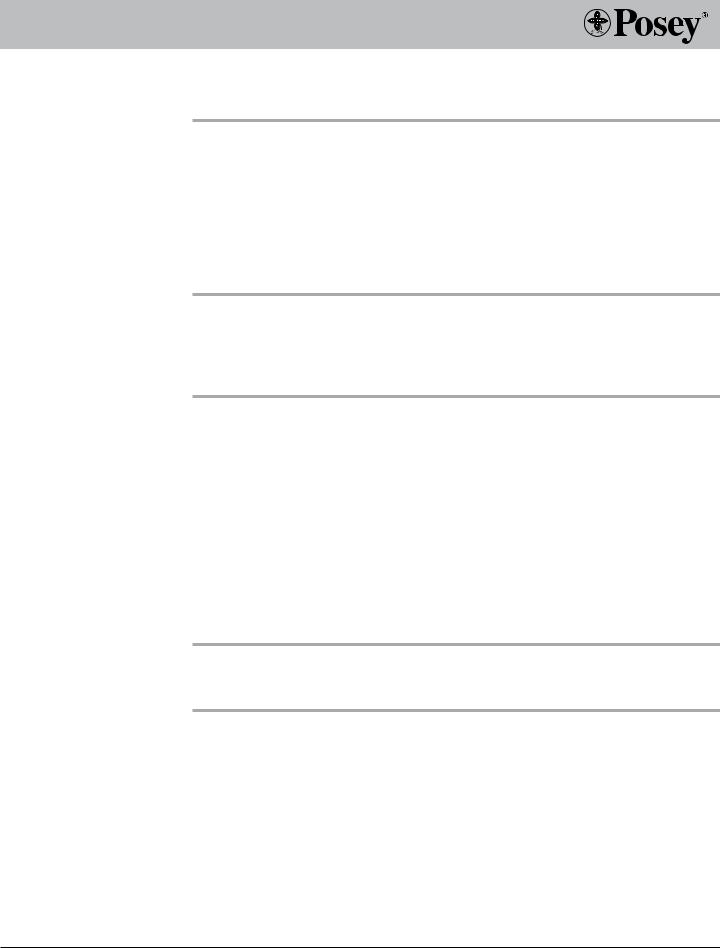
A Special Note
Background
At-Risk Patients
Reducing the Risk
of Entrapment
Alternative Method
of Treatment
All hospital beds pose safety and entrapment risks. The U.S. Food and Drug Administration (FDA) received approximately 803 entrapment reports in the U.S. for standard hospital beds over a period of 24 years from January 1, 1985 to January 1, 2009.3
The FDA formed the Hospital Bed Safety Workgroup (HBSW) to develop solutions to reduce the risk of patient entrapment in hospital beds. The HBSW issued guidelines in 2006 describing seven potential zones of entrapment and recommendations to reduce life-threatening entrapments associated with hospital bed systems.4
The Posey Bed 8070 was designed to help eliminate each of the seven entrapment zones described in the guidelines, when the head of the bed is down and the mattress is flat.
•Patients who, because of mental or physical disability, cannot reposition or remove him or herself from a confined area in the bed.
•Any other patient identified by the physician, the care plan, or Interdisciplinary Healthcare Team (IDHT) to be at risk of entrapment in the gaps created when the head of the Posey Bed is up.
To help reduce the risk of entrapment, do the following:
•Keep the mattress flat.
–If you need to elevate the head or torso of an at-risk patient, keep the mattress flat and use a cushion to position the patient.
–If you must leave the head of the bed up while an at-risk patient is unattended, use the Posey Filler Cushions (Cat. 8021).
•Provide extra monitoring.
–Monitor patient per facility’s restraint protocol to ensure that the Posey Filler Cushions cannot be removed by an at-risk patient and that an at-risk patient cannot crawl under or around the Posey Filler Cushions.
•Avoid stretching the canopy material.
–The canopy may stretch over time during normal use, or due to patients who engage in escape behaviors. This could result in pocket areas on the inside of the canopy. Regular washing and drying should help reduce this condition. DO NOT use any canopy that has tears or damage and request a replacement.
If necessary, consult the physician or the IDHT to find an alternative method of treatment for any at-risk patient.
3 This report can be found at http://www.fda.gov/ForConsumers/ConsumerUpdates/ucm164366.htm
4Guidance for Industry and FDA Staff – Hospital Bed System Dimensional and Assessment Guidance to Reduce Entrapment. March 10, 2006). This report can be found at http://www.fda.gov/MedicalDevices/DeviceRegulationandGuidance/GuidanceDocuments/ucm072662.htm
Posey Bed 8070 |
7 |

Patient Reassessment
Alternatives to Restraint Use
Reassess the need for use of the Posey Bed as the patient’s mental or physical health or status changes. Use the Posey Bed only if there is not a less restrictive alternative. Always use the least restrictive device available for the shortest time while you seek a less restrictive alternative.
Review the patient’s mental and physical status often to ensure that the benefits of using the Posey Bed as a restraint outweigh the risks.
Safe use requires that:
•You define and remove, if possible, the cause of the symptoms that require a restraint. This may include catering to individual needs and routines; increased rehabilitation; restorative nursing; modifying the environment; or increased supervision.
•You tailor interventions to the individual needs of the patient after weighing factors such as the patient’s condition; behaviors; history; and environment.
When possible, seek guidance from the patient’s family. Depending on the patient’s condition, alternatives to restraints may include one of more of these:
•A bedside companion,
•Fall alarms,
•Floor cushions,
•Lowering the volume on the TV,
•Adjusting window shades or dimming lights,
•Soft music, or
•Use of a Posey Activity Apron
As with all restraints, the Posey Bed should never be used for nursing convenience.
8 |
Posey Bed 8070 |
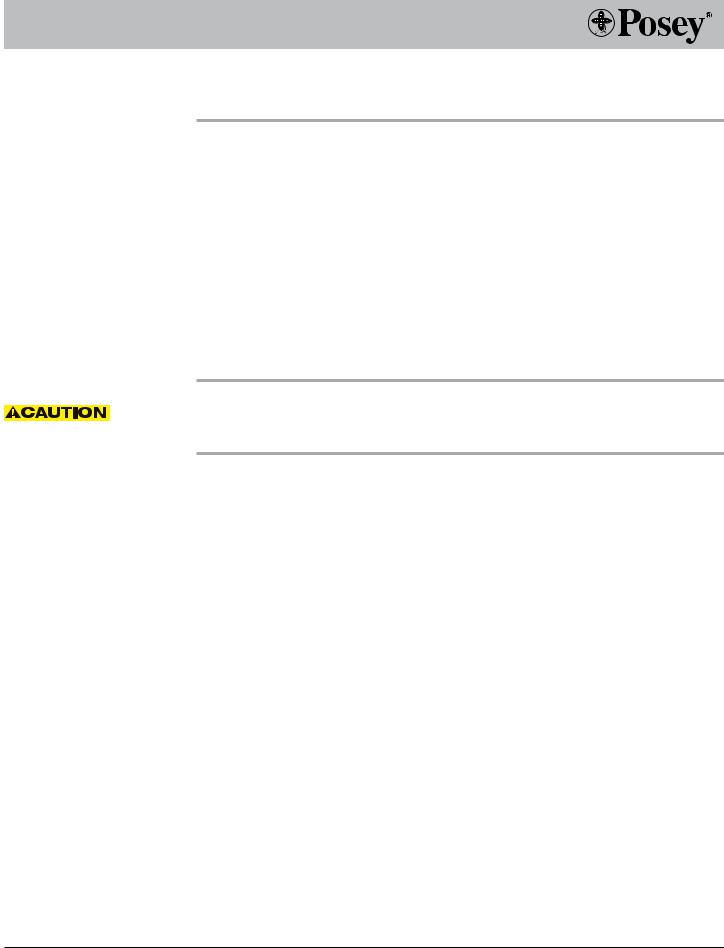
Description of the Posey Bed 8070
Bed Features and
Benefits
•Fully Automatic Low Hospital Bed
Mattress level can be lowered to 19 inches (48 cm), and can be raised to 30 inches (76 cm).
•6 inch (15 cm) Enclosed Mattress Compartment
Helps avoid the risk of a patient being trapped under the mattress
•Nylon Canopy System
A 70 cubic foot (2 cubic meters) rectangular green canopy surrounds the bed. The nylon is biocompatible. The canopy has four (4) access panels for easy access to the patient, and multiple ports for intravenous lines, the Nurse Call Button, and drainage line. Zippers are secured with Quick-Release Buckles.
•Perimeter Guards
A soft side rail is located on each side of the bed when a ‘U’ side panel is open during patient care.
The Posey Bed 8070 canopy is designed to only be used on a modified Joerns Bed model number 2003DC #B684DC, and should not be used on any other bed platform.
Posey Bed 8070 |
9 |
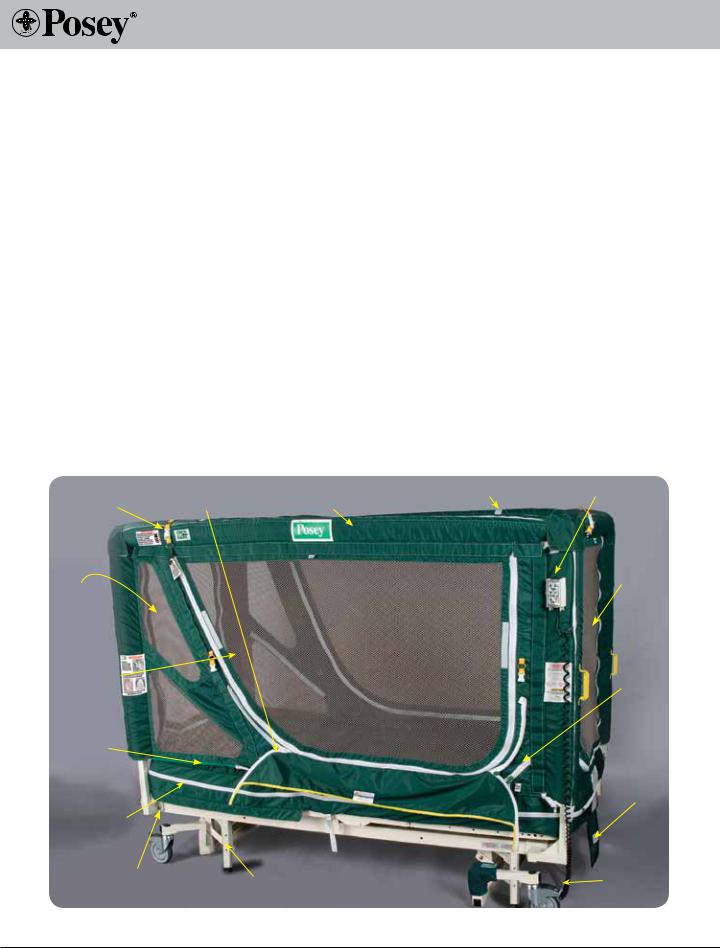
Parts of the Posey Bed 8070 System
1.Enclosed Mattress Compartment. Accommodates a 6 inch (15 cm) mattress.
2.Nylon Canopy. The nylon material is water-repellent.
3.Two ‘U’ Side Panels. One (1) panel on each side with a single zipper on each panel for easy patient access.
4.Head (4a) and Foot (4b) Access Panels. Helps provide easy access to the head and foot of the bed with a single zipper on each panel.
5.Quick-Release Buckles. Clipped to zipper pull-tabs for added patient security.
6.Perimeter Guards. Function like soft side rails for temporary use during patient care and must be unzipped when side panels are closed.
7.Foam Canopy Pads. Ten (10) pads fit around the canopy frame to help reduce the risk of injury from contact with the frame.
8.Hook and Loop Tabs. Secure the ‘U’ side panels to the top panel of the canopy when the side panels are open.
9.See-Through Bed Control Pocket. Holds the Bed Control.
10.Side Panel Tube Ports. Four (4) ports, one on each side at the head and foot of the canopy, to run tubes into the patient compartment.
11.Posey Bed Instruction Storage Pocket. Stores all product Manuals and the “Quick-Check 10” for easy reference.
12.Locking Casters. To secure bed during patient transfers to and from the bed and when patient is unattended.
13.Transfer Brakes. To add stability when the patient is unattended and to help reduce the risk of bed movement during patient transfers.
14.Double Insulated Power Cord. Approved by UL, CSA, TUV, NFPA, NEC and OSHA.
|
6. Perimeter |
7. Foam |
8. Hook and Loop Tab |
9. Bed Control Pocket |
5. Quick-Release |
Guard |
Padding |
|
|
Buckle |
|
|
|
|
|
|
|
|
4b. Foot |
|
|
|
|
Access |
4a. Head |
|
|
|
Panel |
|
|
|
|
|
Access Panel |
|
|
|
|
|
|
|
|
10. Side |
3. Nylon ‘U’ |
|
|
|
Panel |
|
|
|
Tube Port |
|
Side Panel |
|
|
|
|
|
|
|
|
|
2. Nylon |
|
|
|
|
Canopy |
|
|
|
11. |
|
|
|
|
Instruction |
|
|
|
|
Storage |
|
|
|
|
|
1. Mattress |
|
|
|
|
Compartment |
|
|
|
|
14. Double Insulated Power Cord |
13. Transfer |
|
12. Locking |
|
(Located at Head of Bed) |
Brake |
|
Caster |
|
10 |
Posey Bed 8070 |

Warnings and Precautions
Canopy Gaps
Risks Associated with Suffocation or Choking
Risk of Fall or Unassisted Bed Exit
Violent or Aggressive Patients
Importance of Adhering to a Care Regimen
Entrapment risk for certain at-risk patients include canopy gaps. Raising the head
of the Posey Bed will create “gaps” or
“pockets” between the head of the bed and the canopy. These areas pose an
extreme risk of serious injury or death from entrapment to certain at-risk patients. Keep the mattress flat with the head of the bed
down, when an at-risk patient is unattended. Use Posey Filler Cushions (Cat. 8021) if an at-risk patient’s head or torso must be elevated (for example, while watching TV, or if called for by the physician’s order or the patient’s care plan). If filler cushions are not available, lower the bed to the flat position and use a Posey Torso Cushion (Cat. 8025) or another wedge cushion.
To help reduce the risk of suffocation, do the following:
•Never put a mattress inside the patient area,
•Always keep the mattress in the mattress compartment, completely zipped,
•Keep tubes or monitoring lines and the Nurse Call Button inside the bed only if authorized by the care plan.
Never use the Posey Bed if there is damage to the canopy, access panels or zippers. A failure to heed this warning may result in patient escape or unassisted bed exit, which may lead to serious injury or death from a fall. Always check the canopy and the zippers before leaving the patient unattended to help reduce the risk of a fall or unassisted bed exit.
Never leave a patient unattended if the zippers do not close securely, there are holes in the canopy or netting, the foam padding covering the metal frame is damaged or missing, or the frame is damaged.
Never leave a patient in the Posey Bed if they have a risk of self-injury; injury to others; the bed tipping over; or if the patient tries to damage the bed.
•Be aware that a sudden mood swing may cause violent or aggressive behavior. Follow your facility’s security policy, the care plan or the physician’s orders for such patients.
•A patient who may become violent or aggressive may require constant monitoring or alternative methods of restraint.
•No level of monitoring may avoid risk of serious injury to certain violent or aggressive patients, i.e. patients who flail from side to side attempting to tip over the bed or injure themselves against the frame.
•Use of the Posey Bed by an agitated patient or a patient who tries to escape must be approved by the physician or the IDHT when tube(s) or line(s) are in use. There is a risk of serious injury or death if the patient becomes entangled, or disrupts the integrity of a tube or monitoring line.
•Watch for signs of claustrophobia, or a significant increase in stress or physical movement. Remove these patients from the Posey Bed immediately and notify the physician. You may need to find a different method of treatment.
Failure to comply with the physician’s order, the patient’s care plan and all instructions, warnings and cautions in the manual and on all labels on the Posey Bed, could result in patient death or serious injury. Monitor the patient’s condition according to your facility’s policy, the physician’s orders, and the care plans.
Posey Bed 8070 |
11 |
